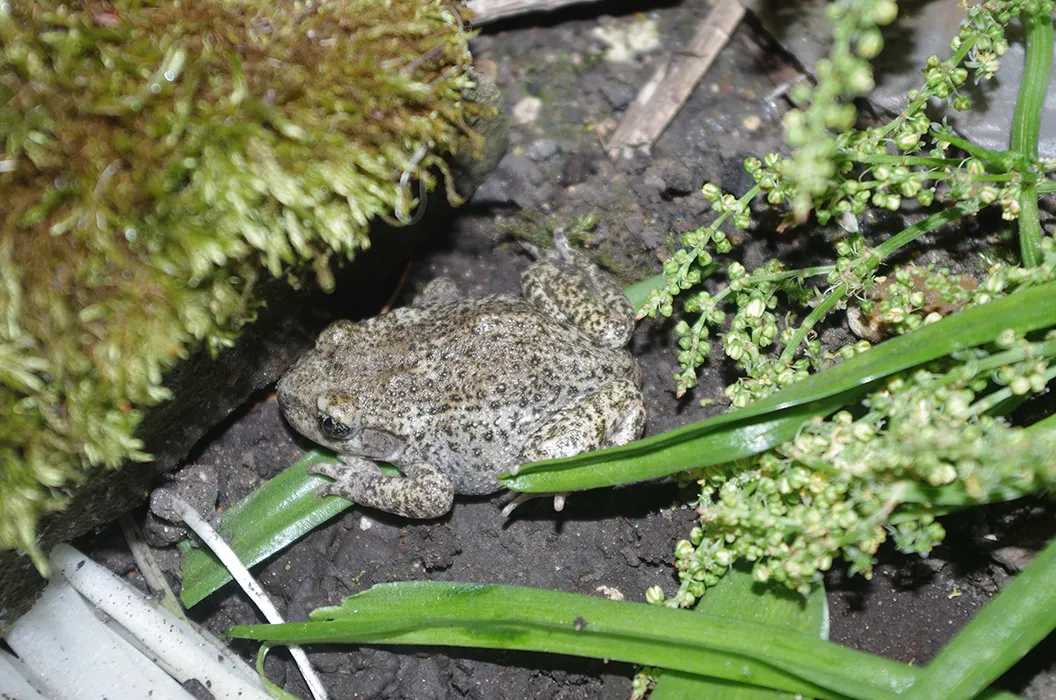The midwife toad, so named after their unusual mating system with the male taking responsibility for the eggs after fertilisation, include five species of toad found across Europe and northwest Africa.
The common midwife toad is the only species in the UK after being introduced here over 100 years ago. Populations are mostly based in Bedfordshire, Yorkshire, Nottinghamshire and Northamptonshire.
Small in size but big on sound, both males and females make a clear, high-pitched whistling noise which they use to attract a mate. This sound has been described as an electronic ‘beeping’ noise like the low battery sound from a smoke detector.
Read on to find out more about the midwife toad in our expert guide by Steve Allain:
Learn more about frogs and toads:
What is the scientific name of the midwife toad?
The scientific name of the midwife toad is Alytes obstetricans.
All midwife toads used to belong to the family Discoglossidae along with the genus Discoglossus, although this has recently been renamed Alytidae. There is evidence to suggest that the family should be split as Alytes and Discoglossus differ enough to be given their own families. Watch this space! The Critically Endangered Majorcan midwife toad (Alytes muletensis) is what is known as a Lazarus species, first being described from fossils (as Baleaphryne muletensis in 1977) before being found in wild in 1979.
What is a midwife toad and how did they get their name?

Midwife toads are non-native toads characterised by their parental care with males carrying strings of fertilised eggs entwined around their hind legs. The males carry their eggs for up to 6 weeks at which point they are ready to hatch where he deposits them in a suitable body of water.
Midwife toads are markedly smaller than our native amphibians growing to 5 cm in length (about the same size as a 50 p coin). Midwife toads feed mainly on small invertebrates they find among the undergrowth and may live up to 8 years in the wild.
Please note that external videos may contain ads:
Midwife Toad (Alytes obstetricans) - European Herptiles. | Jack Perks Wildlife Media
Where are midwife toads native to?
Midwife toads are found throughout Western Europe (including Majorca) and North Africa, with there being 5 species in total.
We currently only have the common midwife toad present in the UK which have a distribution ranging from Spain to Germany. Fossil evidence suggests that they once occurred naturally in the UK but for whatever reason they went extinct.
Where did the midwife toads come from?
It is assumed that the UK’s midwife toads came from northern France as stowaways among a shipment of plants to a garden nursery in Bedford. From here, the toads have since been moved around to found new populations.
However the toads were once a popular pet so it is reasonable to assume that some populations may have been founded independent of the Bedford toads. Researchers are currently trying to solve this puzzle.

Where can midwife toads be found?
Across their native range, midwife toads can be found throughout a number of different habitats from arable land, forests and wetlands. Here in the UK, they are mainly restricted to urban areas close to their initial release sites with populations across England and Wales.
The evidence so far suggests that most populations haven’t dispersed too far from their original site of introduction which may be for a number of reasons such as barriers or a lack of suitable habitat features.
Please note that external videos may contain ads:
Midwife Toads on The One Show (2010) | British Herptology
What do midwife toads sound like?
The call of midwife toads has been historically likened to that of a bell but in more recent times, to that of an electronic alarm. Like most frogs and toads, midwife toads call to attract a mate which can lead to quite a chorus forming especially if there is a high density of males present.
Are they a threat to native amphibians?
Limited screening of midwife toads has shown that they are negative for the amphibian chytrid fungus (Batrachochytrium dendrobatidis) that has been implemented in the decline and extinction of amphibians globally.
Midwife toads breed at a different time of year to our native amphibians and after a brief stint as a tadpole, they live entirely terrestrially. Therefore the chances of competition are low, especially given that midwife toads live alongside our native amphibian assemblage throughout their native range.
Are midwife toads endangered?

The common midwife toad is currently listed as Least Concern by the IUCN Red List, mainly in part due to their large geographical distribution. However populations are decreasing across their range due to threats such as habitat loss and disease. The introduced populations in the UK at the moment appear to be stable but further research is needed to quantify this.
Steven Allain is an avid herpetologist, photographer, researcher and science communicator. His research covers a range of topics, which most recently has involved investigating the population dynamics of grass snakes and the effects of ophidiomycosis.
One of his main missions outside of his research is to communicate the growing need for interest in the conservation of amphibians and reptiles.
Steven also helps to engage members of the public through a number of different means such as via social media and podcasts, to answer their questions about amphibians and reptiles, whilst also reiterating whilst these two groups of animals are vital components of a healthy ecosystem.
Main image: Midwife toad. © Michel Viard/Getty
